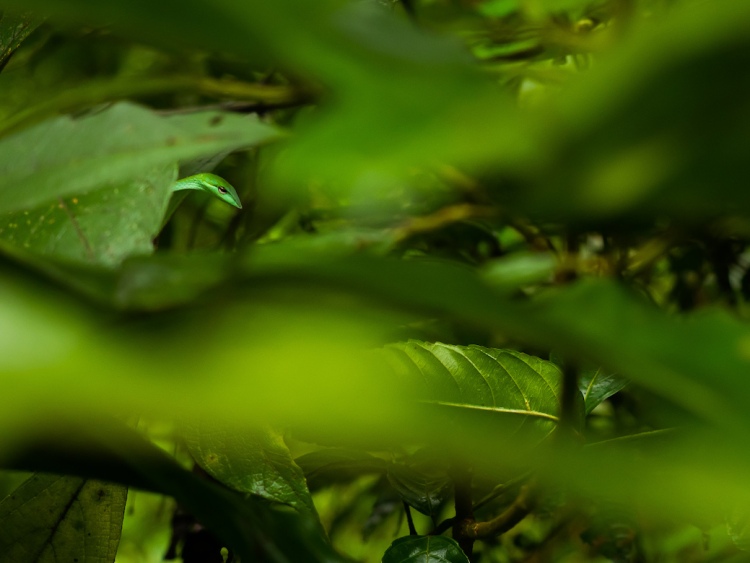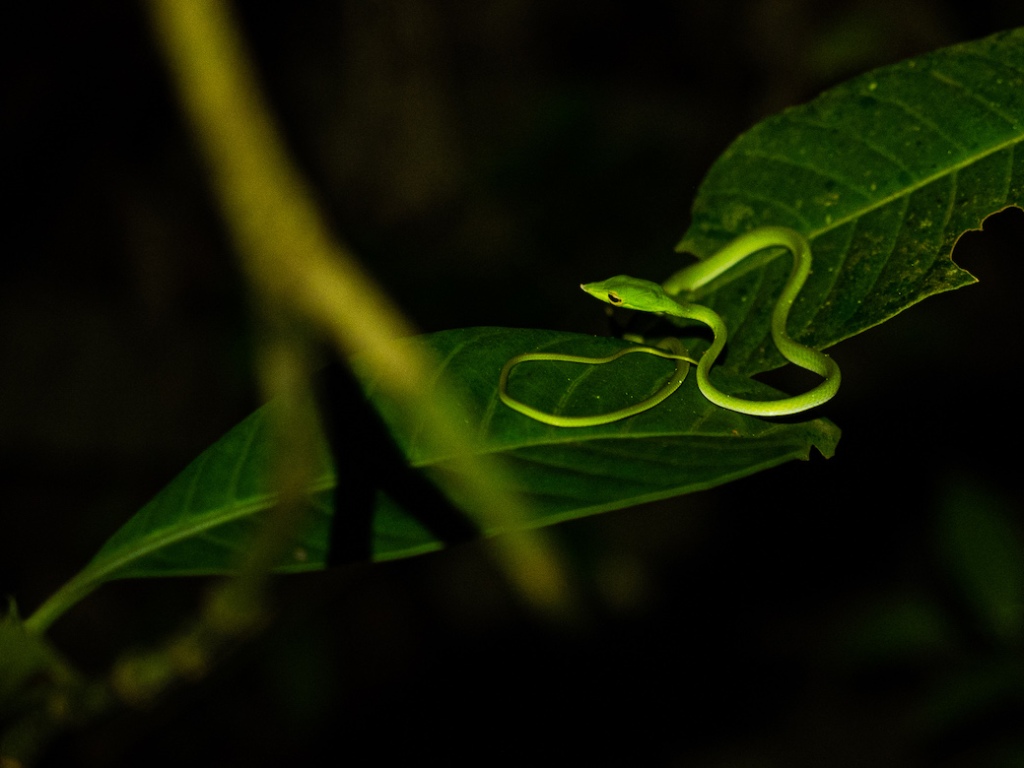“If you had to choose one snake to be your favourite, what would it be?”
I have been asked this question many times. My friends, knowing my interest in herpetology, are keen on knowing which snake I like the most. But whenever they ask, I always give them the same reply, “All snakes are beautiful in their own right”.
But that doesn’t mean that I don’t have a few favourites.

The Green Vine Snake (Ahaetulla nasuta) is one such favourite. It is a medium-sized, slender snake found in the Indian Subcontinent and a few neighbouring countries like Sri Lanka and Bangladesh. This herp is mildly venomous, feeding primarily on lizards and frogs, but can also eat small birds. Their venom, while medically insignificant to humans, is capable of paralysing these tiny creatures, allowing the snake to devour them whole.
It is hard to describe how I fell in love with this snake. It all started in late 2017 when I made a trip to Kalinga Centre for Rainforest Ecology (KCRE) in Agumbe, Karnataka. KCRE is a research station located deep in the rainforest, where they study the ecology of various rainforest species.
Over there, we saw a host of different creatures. Frogs, spiders, butterflies—you name it. We even witnessed a rescue of a King Cobra ( Read about it here). At night, we would walk along the forest trails with a torch, looking for critters in the undergrowth.
To the casual onlooker, this snake might appear indistinguishable from any vine. That is how the snake has evolved. Its camouflage is so perfect that during the day, it’s impossible to find it among the foliage. One could easily walk past it without noticing its presence.

During one of these nightly `herping’ adventures (that’s what we call it), we found a juvenile vine snake along a twig. He was asleep, its characteristic horizontal pupil shut. When I saw him, I fell instantly in love.
To the casual onlooker, this snake might appear indistinguishable from any vine. That is how the snake has evolved. Its camouflage is so perfect that during the day, it’s impossible to find it among the foliage. I recall admiring at how well adapted it was to its environment. One could easily walk past it without noticing its presence.

Vine snakes exhibit some fascinating behaviour. They imitate a vine swaying in the wind when they move, oscillating back and forth as they inch their way forward. This is to disillusion any onlookers and have them believe that it is just an ordinary vine. It’s the most wondrous phenomenon, a testament to years of evolution. In all my subsequent encounters, I have marvelled at this phenomenon.
That one chance sighting sparked a love that would span many years. I was ( and still am) consumed by all things wildlife, and thus I would repeatedly return to KCRE to be in the presence of these creatures. I would go out at night and scan each life, hoping to find a vine snake or a bush frog. I recall spending hours with them, simply watching them bask or sleep.
Subscribe to my Newsletter – The Owlet
Every week I send an email with curated links about the Environment, Creativity and the Human Condition!
Over the years, I have found baby vine snakes just a few centimetres long and enormous adults, some reaching 6 feet! I have seen them resting at night, and I have seen them racing through the canopy at day. And each time I’d lay my eyes on them, I’d be overcome with the same wonder I was all those years ago.

These snakes have several factors that separate them from other snakes. They have horizontal pupils, something found in a few other snakes. They are viviparous, meaning that they give birth to live young. When threatened, they inflate their bodies, revealing a black and white inter-scale colouration. (Sadly, many photographers intentionally disturb the snake to photograph this phenomenon. This is entirely unethical. It must only be shot under natural circumstances.)
One myth many believe about this snake is that when it feels vulnerable, it strikes the eye of the person closest to it. This happens because vine snakes often hang down from the canopy, hoping to catch birds that fly by. Unwary passers-by bump their heads into the snake, thus invoking this reaction. Some needlessly kill them for this behaviour.

So do I have a clear answer as to why I am so drawn to this particular snake? No. But why must I have an answer in the first place? Passion, in whatever form, exists without explanation. It is that irrational love one feels, an emotion indescribable in any language. I love this snake passionately and hope this article and images do justice to this mesmerising reptile.
If you found this insightful, consider subscribing! You’ll sign up for my personal newsletter, exclusive content and more!
Enter your email ID below. You will receive an email asking you to confirm your subscription. Once you confirm, sit back and enjoy content delivered right into your inbox. It’s free!

Such a sweet write up, Ishan 🙂
LikeLike
Thanks Malaika! Means a lot coming from you 🙂
LikeLike
It’s sweet, the way you talk about them. Appreciate it!!!
Since you are an Ashokan, you should meet this guy called Aditya Satish. You two will have much to talk about!!
LikeLike
Thanks!
Yes I know Aditya! We both connected through the organisation I mention in this article!
LikeLike